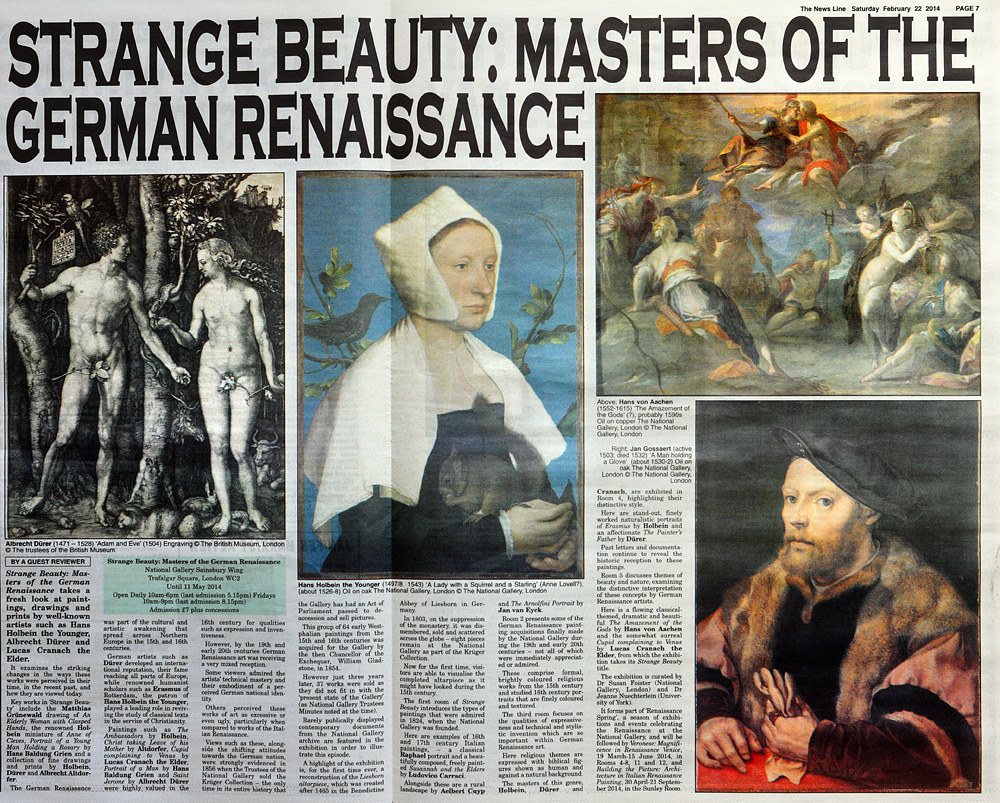 |
|
The
News Line STRANGE BEAUTY: MASTERS OF THE GERMAN RENAISSANCE BY A GUEST REVIEWER Strange Beauty: Masters of the German Renaissance National Gallery Sainsbury Wing Until
Open Daily
Admission 7
Strange Beauty: Masters of the German Renaissance takes a fresh look at paintings, drawings and prints by well-known artists such as Hans Holbein the Younger, Albrecht Dürer and Lucas Cranach the Elder. It examines the striking changes in the ways these . works were perceived in their time, in the recent past, and how they are viewed today. Key works in 'Strange Beauty' include the Matthias Grünewald drawing of An Elderly Woman with Clasped Hands, the renowned Holbein miniature of Anne of Cleves, Portrait of a Young Man Holding a Rosary by Hans Baldung Grien and a collection of fine drawings and prints by Holbein, Dürer and Albrecht Altdorfer. The German Renaissance was part of the cultural and
artistic awakening that spread across German artists such as Dürer developed an
international reputation, their fame reaching all parts of Paintings such as The Ambassadors by Holbein,
Christ taking Leave of his Mother by Altdorfer, Cupid complaining to Venus
by Lucas Cranach the Elder, Portrait of a Man by Hans Baldung Grien and However, by the 19th and early 20th centuries German Renaissance art was receiving a very mixed reception. Some viewers admired the artists' technical mastery and their embodiment of a perceived German national identity. Others perceived these works of art as excessive or even ugly, particularly when compared to works of the Italian Renaissance. Views such as these, alongside the shifting attitudes towards the German nation, were strongly evidenced in 1856 when the Trustees of the National Gallery sold the Kruger Collection - the only time in its entire history that the Gallery has had an Act of Parliament passed to de-accession and sell pictures. This group of 64 early Westphalian paintings from the 15th and 16th centuries was acquired for the Gallery by the then Chancellor of the Exchequer, William Gladstone, in 1854. However just three years later, 37 works were sold as they did not fit in with the 'present state of the Gallery' (as National Gallery Trustees Minutes noted at the time). Rarely publicly displayed contemporary documents from the National Gallery archive are featured in the exhibition in order to illustrate this episode. A highlight of the exhibition is, for the first
time ever, a reconstruction of the Liesborn altarpiece, which was created
after 1465 in the Benedictine Abbey of Liesborn in In 1803, on the suppression of the monastery, it was dismembered, sold and scattered across the globe - eight pieces remain at the National Gallery as part of the Kruger Collection. Now for the first time, visitors are able to visualise the completed altarpiece as it might have looked during the 15th century. The first room of Strange Beauty introduces the types of paintings that were admired in 1824, when the National Gallery was founded. Here are examples of 16th and 17th century Italian paintings, - a classical Raphael portrait and a beautifully composed, freely painted Susannah and the Elders by Ludovico Carraci. Alongside these are a rural landscape by Aelbert Cuyp and The Arnolfini Portrait by Jan van Eyck. Room 2 presents some of the German Renaissance painting acquisitions finally made by the National Gallery during the 19th and early 20th centuries - not all of which were immediately appreciated or admired. These comprise formal, brightly coloured religious works from the 15th century and studied 16th century portraits that are finely coloured and textured. The third room focuses on the qualities of expressiveness and technical and stylistic invention which are so important within German Renaissance art. Here religious themes are expressed with biblical figures shown as human and against a natural background. The masters of this genre, Holbein, Dürer and Cranach, are exhibited in Room 4, highlighting their distinctive style. Here are stand-out, finely worked naturalistic portraits of Erasmus by Holbein and an affectionate The Painter's Father by Dürer. Past letters and documentation continue to reveal the historic reception to these paintings. Room 5 discusses themes of beauty and nature, examining the distinctive interpretation of these concepts by German Renaissance artists. Here is a flowing classical-themed, dramatic and beautiful The Amazement of the Gods by Hans von Aachen and the somewhat surreal Cupid complaining to Venus by Lucas Cranach the Elder, from which the exhibition takes its Strange Beauty title. The exhibition is curated by Dr Susan Foister
(National Gallery, It forms part of 'Renaissance Spring', a season of exhibitions and events celebrating the Renaissance at the National Gallery, and will he followed by Veronese:
Magnificence in Renaissance Venice, 19 March-15 June 2014, in Rooms 4-8, 11 and 12, and Building the Picture: Architecture in Italian Renaissance Painting, 30 April-21 September 2014, in the Sunley Room. |
| www.wrp.org.uk |